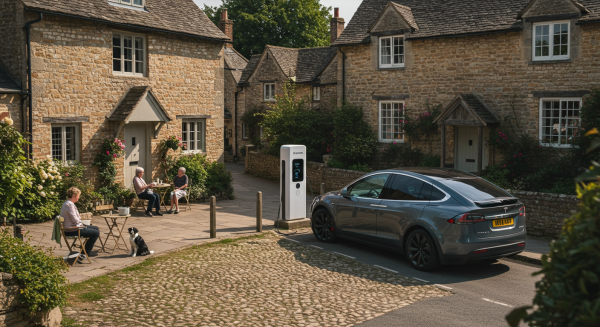Picture driving through the British countryside in an electric vehicle (EV), watching your battery level drop while passing village after village with no charging points in sight. This scenario, often called a “charging desert,” has been one of the main barriers to EV adoption in rural areas. However, the Automated and Electric Vehicles Act 2018 is working to change this landscape.
Strategic Placement of Chargers
The Act empowers the Secretary of State to require large fuel retailers and service area operators to install charging points at strategic locations. Think of it as filling in the blank spaces on a map—ensuring that drivers are never more than a reasonable distance from their next charge. According to the government’s EV Infrastructure Strategy, today a driver is never more than 25 miles away from a rapid chargepoint anywhere along England’s motorways and major A roads.

Local Authority Empowerment
One of the Act’s most significant provisions is its support for local authorities in developing charging infrastructure. Similar to how rural post offices serve as essential community hubs, the Act enables local councils to create charging networks that serve their communities’ specific needs. The legislation provides a framework for councils to access funding and work with private operators to install chargers where they’re needed most.
The Mayor’s Role
An innovative aspect of the Act is how it empowers elected mayors to request charging infrastructure in their regions. When a mayor identifies a charging desert in their area, they can make a formal request to the Secretary of State to require large fuel retailers to install charging points. This creates a direct line between local knowledge and national action.
Smart Charging for Rural Areas
The Act doesn’t just focus on the quantity of chargers but also their quality. It requires charging points to be “smart”—capable of receiving, transmitting, and reacting to information. For rural areas, this means chargers can be monitored remotely, ensuring they’re working when needed and can be maintained efficiently.
Public-Private Partnership
Understanding that rural charging infrastructure might not initially be as profitable as urban locations, the Act creates a framework for collaboration between the public and private sectors. According to the UK Electric Vehicle Infrastructure Strategy, there will be around 300,000 public charge points as a minimum by 2030. This target includes provisions for rural areas that might not immediately attract private investment.
The Road Ahead
While the Act sets the framework, implementation is still ongoing. The challenge remains to ensure that rural communities aren’t left behind in the transition to electric vehicles. However, with the legal framework in place and funding mechanisms established, the groundwork has been laid for filling these charging deserts with the infrastructure needed for an electric future.
By requiring strategic placement of charging points, empowering local authorities, and ensuring smart technology integration, the 2018 Act is gradually helping to ensure that range anxiety becomes a thing of the past—whether you’re in central London or the Scottish Highlands.
